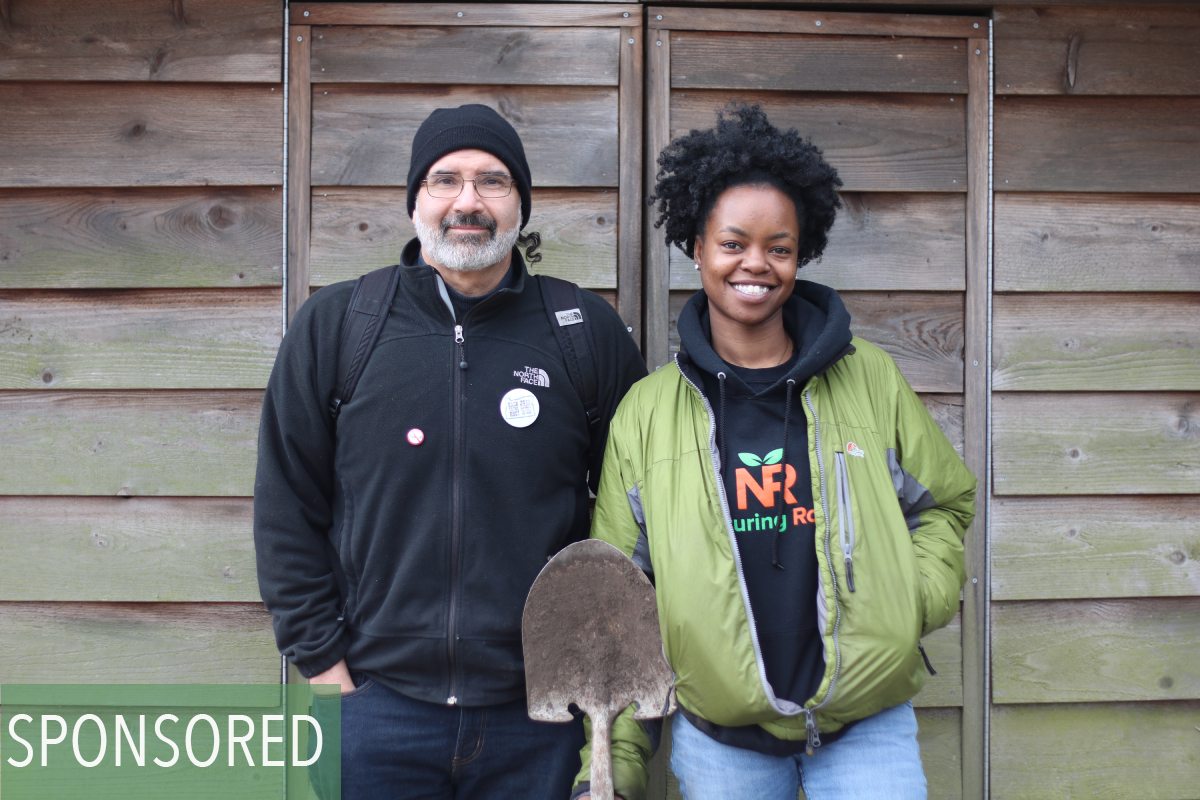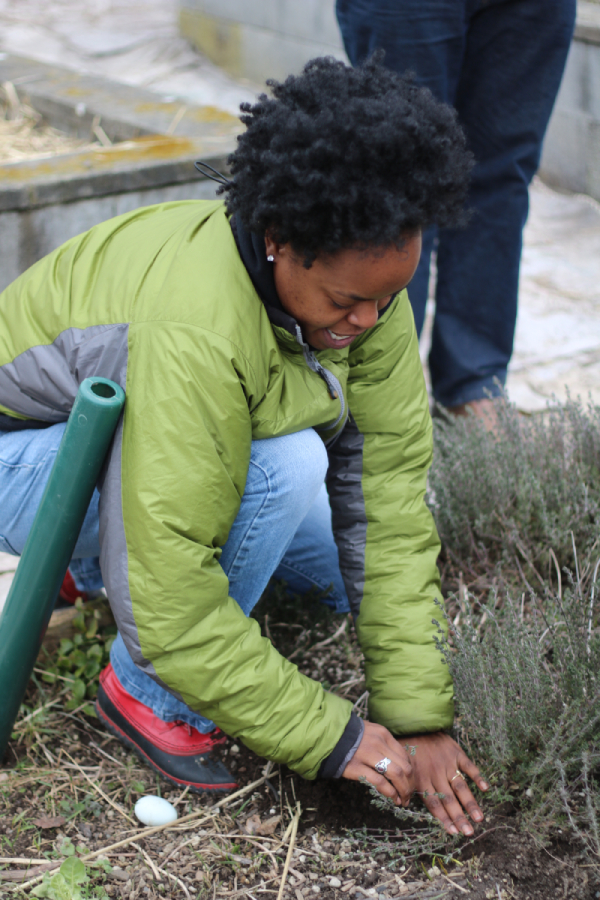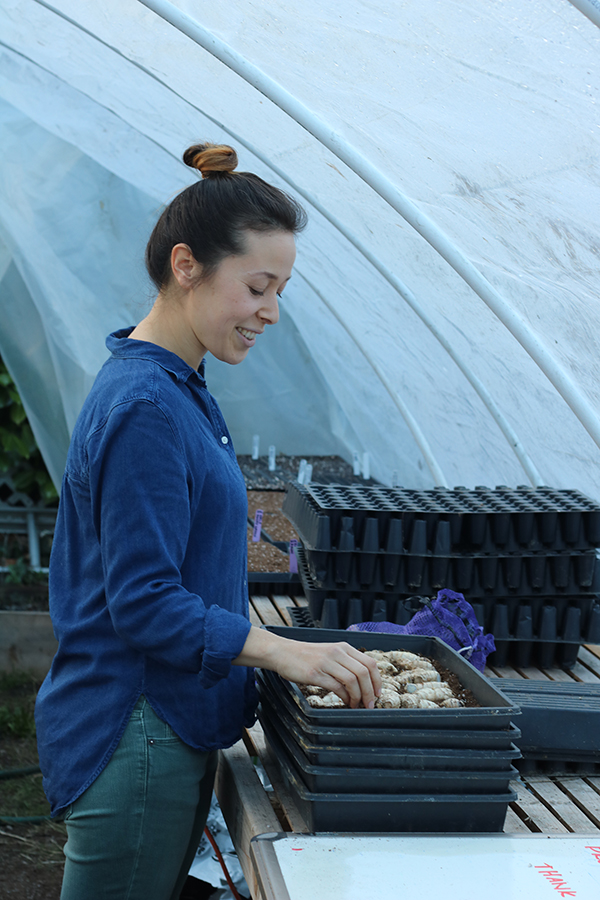
Nurturing Roots farm is nestled away in a little plot of land in Beacon Hill beside the Black Power Epicenter. Its wooden planters are full of resting seeds, covered in hay to stay warm during the winter months until green sprouts unfurl in spring. Nyema Clark, the farm’s owner didn’t know anything about farming when she first began. YouTube was one of her first teachers. She also learned by doing: noticing patterns like the yellowing of leaves and deducing that the plant was in trouble.
She began a business eight years ago at Pike Place Market, where tourists and locals came through and purchased her harvest. The business was profitable, but something didn’t feel right.
“Emotionally, it wasn’t necessarily driving me,” said Clark. She was putting tremendous effort and time into her product and the people who were benefiting from it weren’t even from her community. She felt that those resources were being “taken out.”
That was when Clark pivoted her farming efforts to engaging her own community. She wanted to provide affordable, sustainable alternatives to high-end grocery markets for families living on a meager income.
“When I was younger I wanted to be able to afford things that I knew my parents could not provide,” said Clark. “Being able to teach young people at an early age … how they could turn a tomato into a tomato sauce, dry herbs into a seasoning rub that you can change into a product that you can market, I think that is really where my passion is.”
Ray Williams is an urban farmer and part of the local Black Farmers Collective. He is heading the development of Yes Farm in Yesler Terrace with the goal of improving community health, mental and physical, by growing food and rooting an African American presence in a gentrifying Central District.
Williams said the current image of the urban farmer is that of a white man. According to the 2012 Agricultural census, 95.4% of U.S. farmers were white while 1.6% identified as Black, 1.8% as indigenous, and 0.6% Asian. Williams wants to empower a new generation of young Black Farmers “to show students it’s okay to do this, this is connected to a proud history.”

Racial Histories of Farming
Ariana de Leña owns Kamayan Farm in Carnation. The farm’s name is an homage to their Filipino roots and to a style of communal eating.
Their grandfather immigrated to the U.S. in the 1930s from the Philippines and found work as a farmworker in California. “Lately I’ve been thinking about what it means to restore relationship with the land. I have a duty and obligation to treat that land with reciprocity,” said de Leña.
de Leña’s farm might be in a more rural setting, about an hour’s drive from city limits, but they share some of the same goals and motivations as Williams and Clark who work within urban spaces.
“Farming is really about bringing different folks to land that don’t necessarily have access and making it a point of community,” said de Leña. “And [it is also] a tool for talking about how all of our different cultures are rooted someplace and how they are all rooted in the food that we grow and that we eat.”
de Leña remembers the incident that kindled her interest in working with the land. A professor took their class to a farm in south central Los Angeles. The space was surrounded by warehouses and urban sprawl and had been given to the community after riots in the neighborhood in 1992. Most of the farmers were Black, Indigenous, or Latino and de Lena struck up conversation with one farmer who had brought seeds with him when he came across the border from Mexico. Now he was planting those same seeds with his grandchildren.
“And there was something about it for me that just sparked so much possibility around what growing food can mean. I think the mainstream narrative around food is that people should eat healthy and it’s so much deeper than that,” said de Leña.
In their time working in urban and rural agriculture, both with policy work and grassroots organizing, de Lena did see that white-led spaces brought on their own challenges. One challenge was finding a supportive mentor to “ask deeper questions of” who could be aligned with de Lena’s values.
Most people were in the industry for money and efficiency, but those weren’t the factors that fueled de Leña in their work. de Leña wanted to create a place where people “can feel connected to themselves and their ancestors by tending to plants and the soil.” That made it even more important to find a mentor who would support those goals.

Budding Networks of Support
The cost and resources needed to manage land are also barriers to navigating the agricultural sector. Farming takes a tremendous amount of starting capital and ongoing financial resources to manage the land. Getting credit and purchasing land is much harder for people of color.
That’s where Clark and Williams’ urban farming model is an innovative approach to combat the financial barriers of land access, as they maximize what can come out of tight urban spaces. If a farm is structured around produce, educational experiences and value-added products, “then you can build a sustainable lifestyle where this work is sustainable for the individual as well as the garden, for the city and the planet itself,” Williams said.
The support network for farmers of color is growing. Roots of all Roads is a mobile farm stand and community resource in south Seattle. Roots of all Roads is deliberate in cultivating relationships with farmers of color. In fact, until Clark’s farm became a nonprofit, she used to work at their farm stand to supplement her income.
There are also innovative ways to gain agriculture education without a four-year agriculture degree from a school like Washington State University. New avenues are emerging, like Portland based Mudbone Grown farm and the local Black Farmers Collective.
Williams says that bringing in educational models to farms is what will help show young people of color that a career in agriculture is accessible and beyond the complicated history of land labor and race. “That is the curriculum work that needs to be done,” Williams said. “Really sharing the contributions that different cultures have brought across the U.S. and valuing the farmer, as opposed to devaluing the farmer.”
Reconnecting to the land can be painful, especially when coming face to face with the foundational histories of slavery and indentured labor in the United States. Despite this, Clark, Williams, and de Leña underscore how important it is to recognize that cultures all over the world have intimate and enduring ties to the earth and the bounty of harvest.
Clark often asks her youngest visitors to put sunflower seeds in their mouths before patting them down into the soil, “as a way of giving your intention into the plant before you put it in the ground.” The simple act literally connects children to the natural life cycle from which we are so often removed. Their saliva even helps kick start the germination process.
Urban farming faces its own pressures, especially as development pushes out communities. It definitely won’t solve all problems of access and health in urban communities. But Williams hopes farming initiatives in communities of color can grow produce for the community to ease development pressures, bring in natural wildlife and ultimately cultivate a space for historical healing.
This story is part of a new series about Pathways to Green Jobs by Resource Media to showcase pathways to green jobs for people of color. Last year, Resource Media, Russell Family Foundation, and The Seattle Globalist partnered on “Puget Sound Future-Makers,” a series of stories that recognized the work of diverse leaders in the Puget Sound region in shaping the strength and resilience of our future environment and communities.
Correction (5/2/19 at 7:47 a.m.): A previous version of this story had said the year of the riots in south central Los Angeles was 1982. It’s been corrected to 1992.

